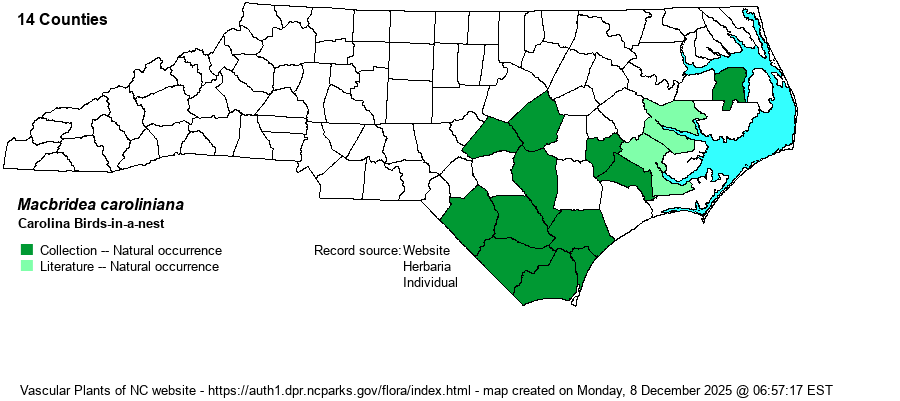| Author | (Walter) S.F. Blake | |
| Distribution | Present over the southern portion of the Coastal Plain, east of the Sandhills region; ranging north to Harnett, Johnston, and Craven counties, with a disjunct record northeast to Tyrrell County (in 2019).
This is a South Atlantic Coastal Plain species, ranging north to southeastern NC but south only to southern GA. Limited only to NC, SC, and GA.
| |
| Abundance | Rare to locally uncommon in a small area from southeastern Robeson County east to western Pender County, mainly in the floodplain of the Waccamaw River, less so in the Lumber River floodplain. Very rare from Sampson County northward. This is a State Endangered species. With a Global Rank of only G3, this is quite a rare mint species in the country. | |
| Habitat | This is a species essentially of blackwater wetlands, mainly found in partly shaded swampy areas, in ditches, and margins of savannas with swamps. Several records have been made in recent clearcuts of blackwater wetland forests. |
| Phenology | Blooms from mid-July to frost, most often in August; fruits soon after flowering. | |
| Identification | This is a beautiful wildflower, especially when a tight colony is in bloom. It is a medium-sized herb, mostly unbranched or with basal branches, reaching 1.5-2 feet tall. It has scattered opposite leaves, each being elliptical to lanceolate, about 4 inches long and 1.5 inches wide, with serrated margins; lower leaves have short petioles but upper ones are sessile. The inflorescence is terminal on a stem, consisting of several rather large and showy flowers, mostly erect and facing outward from the middle of the cluster, tubular but with a hood and a lower lip. Collectively, the several flowers in bloom resemble baby birds in a nest with their necks stretched out and their mouths wide open. Flowers average about 1-inch long, pink, rose-pink, or lavender-pink, often striped with white. Experienced biologists can probably identify this species just by the leaves, but for most people you will need to see the flowers to be sure about claiming a sighting of this rare species. Thankfully, where found it typically occurs in sizable stands of many dozens of stems in a small area. | |
| Taxonomic Comments | None
| |
| Other Common Name(s) | Carolina Macbridea, Carolina Bogmint. Though the "birds-in-a-nest" name seems colloquial, there is one other species, limited to FL, almost always named as White Birds-in-a-nest. Thus, the genus Macbridea is typically known as "birds-in-a-nest" and not as "bogmint". | |
| State Rank | S2 | |
| Global Rank | G3 | |
| State Status | E | |
| US Status | | |
| USACE-agcp | OBL link |
| USACE-emp | OBL link |

